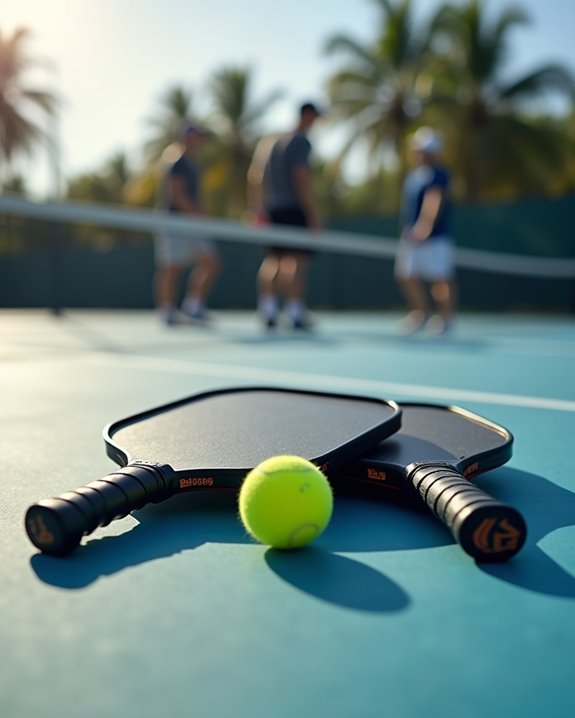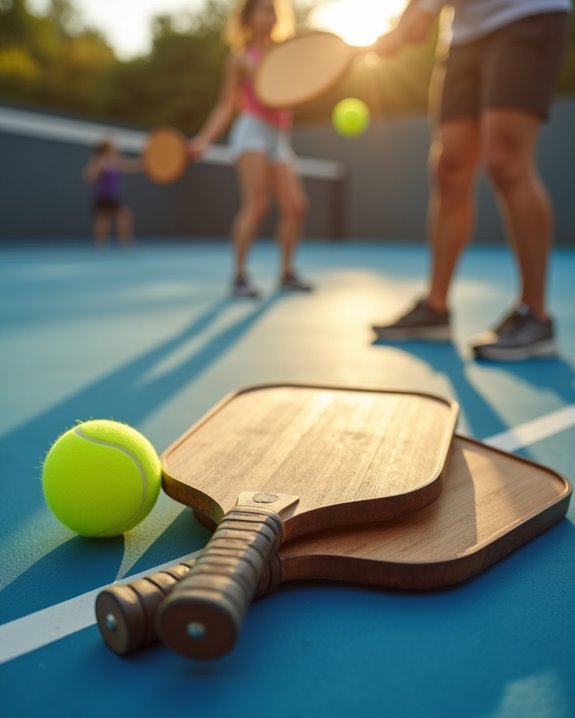When selecting your perfect pickleball paddle, focus on five essential factors: weight (light for maneuverability, heavy for power), grip size (matching your hand measurements), core and face materials (affecting power and control), paddle shape (standard or elongated), and sweet spot size (larger for beginners). Your playing style will determine which features matter most—power players might prefer heavier paddles with Nomex cores, while control-focused players benefit from composite materials. The right paddle becomes an extension of your arm on the court.
Key Takeaways
- Choose the right weight category (light, medium, or power) based on your playing style and comfort level.
- Select an appropriate grip size using height measurements or finger tests to ensure maximum control and comfort.
- Consider core materials like polymer or Nomex based on whether you prioritize control, power, or a balance of both.
- Evaluate paddle face materials such as fiberglass or carbon fiber depending on your need for power or consistency.
- Match paddle shape and sweet spot size to your skill level, with beginners benefiting from wider, more forgiving paddles.
Essential Factors to Pick the Perfect Pickleball Paddle
When you’re standing at the rack of gleaming paddles, how do you know which one will become your trusty court companion? Start by considering paddle weight—lighter paddles (7.2 oz) offer buttery-smooth maneuverability, while power paddles (8.5+ oz) deliver meatier shots.
Next, find your perfect grip size like selecting the right knife handle—4 for players under 5’3″ and 4.5 for those towering above 5’8″. The paddle shape matters too; standard shapes provide a generous sweet spot, while elongated paddles extend your reach like a chef’s long-handled spoon.
Don’t overlook core materials! A polymer core offers the perfect blend of control and durability—much like a well-seasoned cast iron pan. Additionally, consider paddles with polypropylene honeycomb cores as they provide a larger sweet spot and better cushioning for your shots. Take advantage of 30-day test drives to sample different paddles before committing to your perfect match.
Paddle Shape and Dimensions: Finding Your Perfect Fit
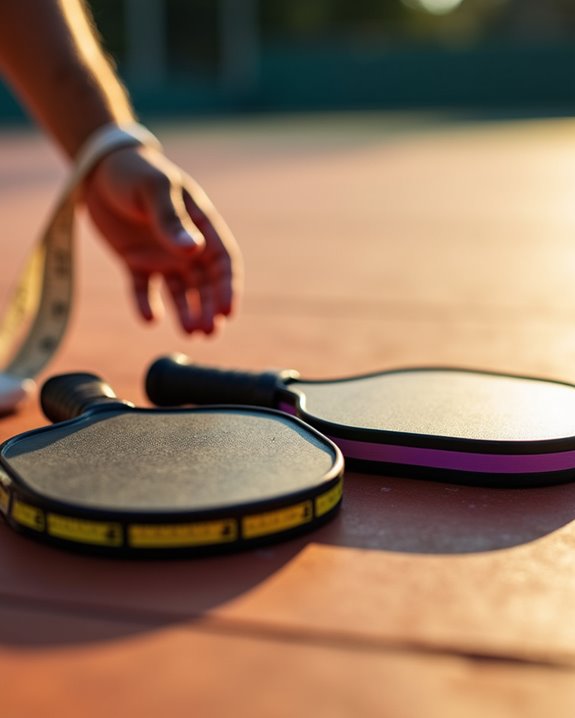
Three key dimensions define your pickleball paddle’s personality on the court: shape, size, and thickness.
When selecting your paddle shape, consider how it affects your game like ingredients affect a recipe. Standard paddles with a wider body serve up a generous sweet spot—perfect if you’re still mastering the basics. For players hungry for reach, elongated paddle options extend 16″ or longer, though they offer a smaller sweet spot.
Paddle thickness (ranging from 10mm to 20mm) also impacts paddle performance considerably. Thicker paddles at 16mm provide stability like a well-set roux, while thinner options enhance maneuverability for quick exchanges at the kitchen line. Remember, USAP regulations limit combined dimensions to 24 inches, so choose wisely to balance control and power for your playing style.
Core Materials: Understanding the Heart of Your Paddle
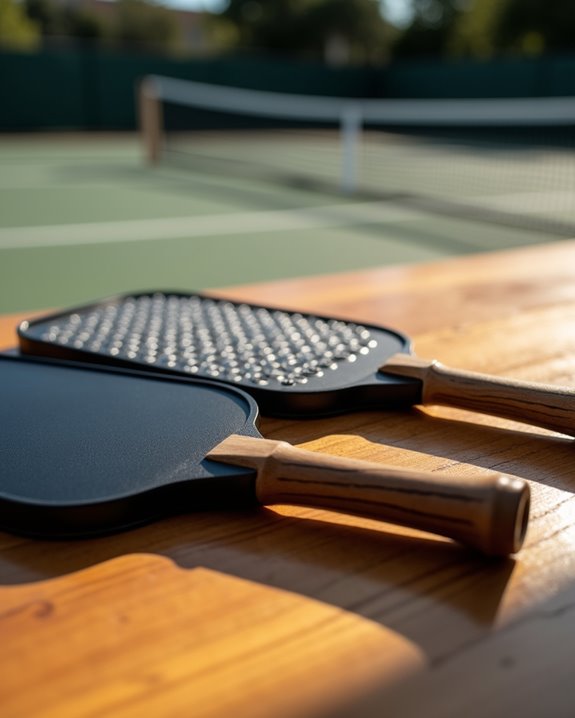
Just as the dimensions of your paddle shape the exterior experience, what’s inside truly determines how your paddle performs on the court. Think of core materials as the secret ingredient that gives your game its distinctive flavor!
Polymer and polypropylene cores dominate the market, offering a perfect blend of durability and lightweight performance—like a well-balanced sauce. Paddle thickness matters tremendously: thicker cores (16mm) provide stability and a larger sweet spot, while thinner ones (14mm) deliver exceptional maneuverability and pop.
Your playing style should dictate your choice. Power players might savor the responsive feel of Nomex, while control-focused players often prefer the forgiving touch of composite cores. Remember, the core’s overall feel should complement your technique, just as the right spice brings out a dish’s full potential. Additionally, core material affects shock absorption and sweet spot size, making it crucial to select the right one for your needs.
Face Materials: Impact on Power, Spin, and Feel

The paddle face serves up the first point of contact with every ball, making it debatably the most essential ingredient in your pickleball recipe. When selecting your perfect paddle, consider how different materials affect your game’s flavor profile.
Fiberglass faces deliver a powerful punch like a robust sauce, though their smaller sweet spot requires precise technique. Carbon fiber, the sous chef of control, offers a forgiving sweet spot that helps you plate precise shots with consistency. For a well-balanced dish, Kevlar composite paddles blend power and control in perfect measure.
Don’t overlook textured surfaces on paddle faces—they’re the seasoning that enhances spin potential, allowing you to serve up shots that curve back into the court like a perfectly reduced glaze. Your playing style should determine which performance characteristics you prioritize.
Weight Classification: Light, Medium, or Heavy
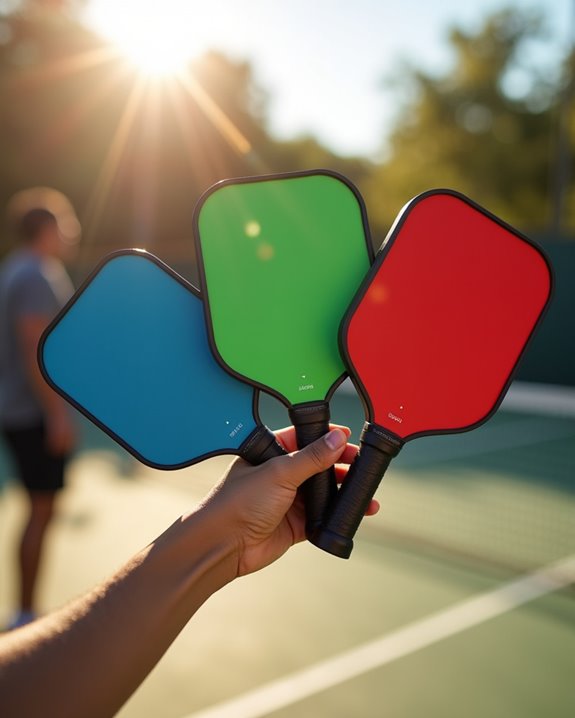
While the face material provides the flavor profile of your paddle, its weight serves as the foundation of your pickleball cooking technique. The paddle weight spectrum offers three main ingredients: light (under 7.2 oz), medium (7.3-8.4 oz), and heavy (8.5+ oz).
Light paddles bring nimble maneuverability to your game—perfect if you’re nursing injuries, though you’ll need extra muscle for powerful shots. Medium paddles offer a balanced recipe of control and power that most players find deliciously playable, especially beginners. Heavy paddles deliver a hearty portion of stability and power but might strain your wrist over time.
Your ideal paddle weight depends on personal preference—like selecting the right knife for your culinary style. Try different weights to discover which one feels like an extension of your arm.
Grip Size and Measurement Techniques
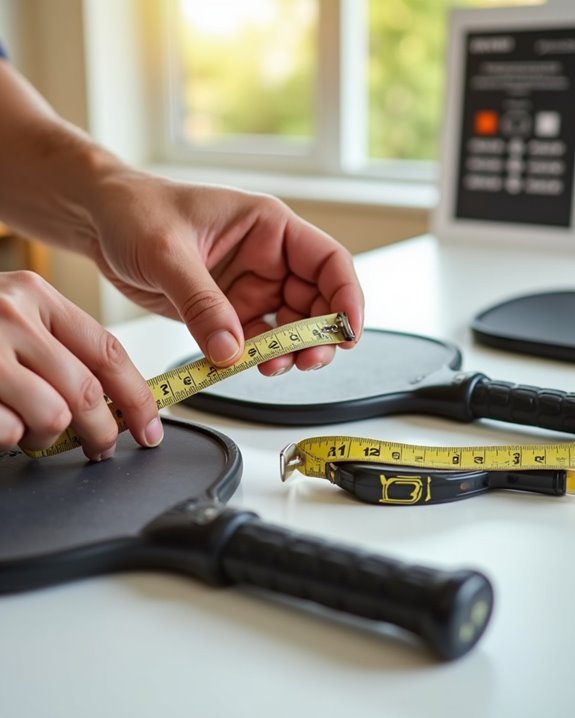
How comfortably your paddle rests in your hand might be the secret ingredient to your pickleball success. Like finding the perfect whisk for your soufflé, selecting the ideal grip size guarantees maximum control and comfort on the court.
Most grips range from 3⅝ to 4½+ inches in circumference. To find your perfect grip size, try the height test: if you’re under 5’3″, aim for 4 inches; between 5’3″ and 5’8″, go for 4¼ inches; above 5’8″, choose 4½ inches. For more precision, use the finger test by measuring from your palm’s middle crease to your ring fingertip.
Handle Length: Short vs. Standard vs. Long
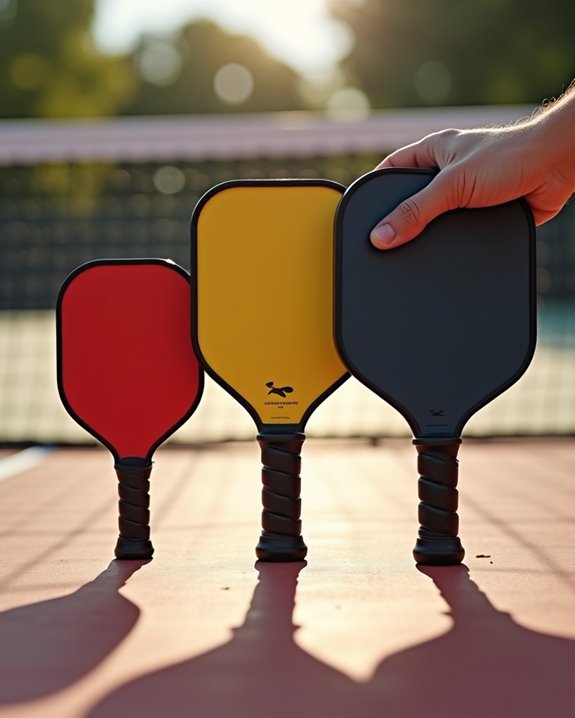
Why might handle length matter as much as the ingredients in your favorite recipe? It’s the foundation that determines how your pickleball skills will blend together!
Short handles (4¾ inches) are like precision knives—offering superb maneuverability for one-handed backhands by keeping the sweet spot closer to your hand. Standard handles (5 to 5¼ inches) function as your all-purpose mixing bowl, versatile enough for most players without requiring two-handed grips.
Craving extra reach? Long handles (5½+ inches) deliver the leverage you need—perfect for two-handed backhands, just as a long-handled spoon helps you stir deep pots.
Your choice greatly affects control and comfort. Remember, longer handles raise the sweet spot position, potentially altering your overall performance. Select a length that feels like an extension of your arm!
Player Style Compatibility: Power vs. Control vs. Balance
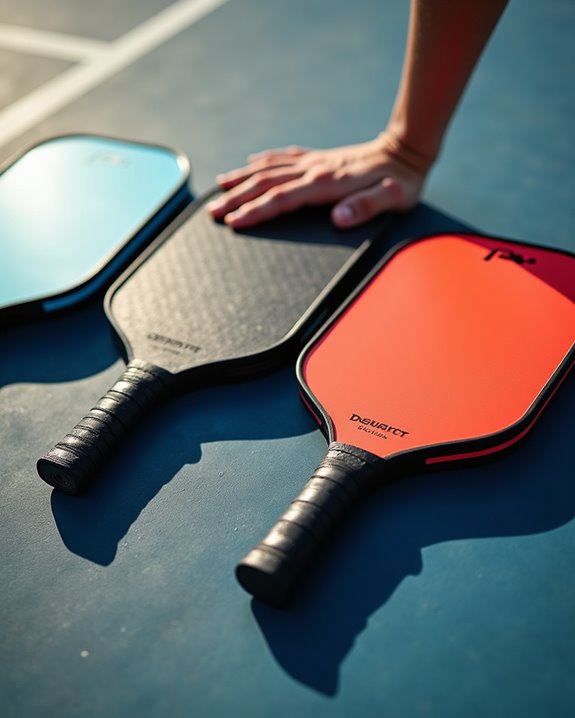
With your handle selected, let’s heat up the conversation about paddle personality!
Your playing style should be the main ingredient in your paddle recipe. If you’re hungry for power, look for elongated shapes with thinner cores that let you serve up blistering shots. These lighter paddles simmer with speed but require precise timing. Control players should fold in thicker cores that absorb energy like a sponge, creating a larger sweet spot for consistent returns. Your grip size matters too—smaller grips for wrist-flicking finesse, larger ones for stability when power-hitting.
Paddle weight and thickness blend together to complement your player type. Heavier paddles (8.5+ oz) pack more punch but require skilled handling, while varying paddle thickness (8-20mm) affects both pop and stability. Remember, the perfect paddle balances these elements to match your unique flavor of play. Additionally, consider paddles with polymer honeycomb cores that enhance durability and performance for a balanced playing experience.
Sweet Spot Size and Paddle Forgiveness
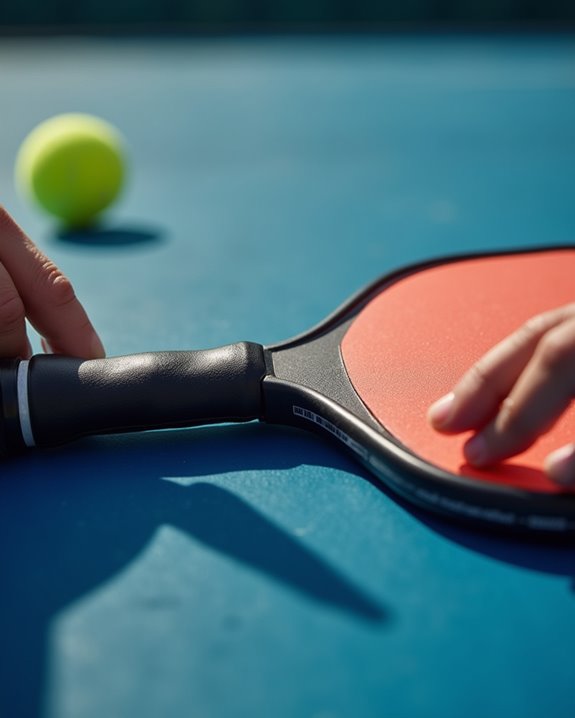
Forgiveness in a pickleball paddle isn’t about pardoning missed shots—it’s about the paddle’s ability to salvage them! When you’re hunting for your ideal paddle, sweet spot size should be near the top of your ingredient list.
Wide-body paddles serve up larger sweet spots, perfect if you’re still mastering your technique. Like a well-kneaded dough, thicker cores (16mm) spread forgiveness across the paddle face, absorbing off-center hits without sacrificing control.
Be cautious with elongated paddles. Though they extend your reach like a chef’s long spoon, their tighter sweet spots require more precise contact.
For the perfect recipe, consider paddle shape and material. Composite faces blend power and spin while maintaining a forgiving feel, ensuring your pickleball experience remains sweet rather than bitter.
Budget Considerations and Value Assessment

How much should you spend on your pickleball paddle when prices simmer anywhere from $50 to a sizzling $250? The answer depends on your skill level and commitment to the game.
For beginner paddles, a $50-$100 range offers plenty of flavorful options to start your pickleball journey. As you develop a taste for the sport, you might crave advanced models with premium ingredients like carbon fiber faces.
When shopping, fold in value assessment by comparing performance ratings against price. Many mid-range paddles serve up the perfect cost-to-performance ratio with high ratings for control and spin. Look for promotional codes that can yield significant savings—often slicing $10 off even quality paddle prices.
Frequently Asked Questions
How to Pick Out a Good Pickleball Paddle?
To pick a good pickleball paddle, consider your playing style, paddle materials, weight, grip sizes, edge guard, and sound quality. Compare brands, price ranges, durability factors, and even color choices that suit you.
What Makes One Pickleball Paddle Better Than the Other?
The ABSOLUTELY PERFECT paddle for you depends on your play style! You’ll find paddle weight, grip size, surface material, length, core thickness, balance point, edge guard, handle shape, and brand reputation all dramatically affect your comfort and performance.
What Is the Best Pickleball Paddle for an Average Player?
You’ll want a paddle weighing 7.3-8.4 oz with a 4¼-4⅜” grip size. Look for composite materials, medium texture, $75-150 price range, respected brands offering warranties. Consider standard length, comfortable handle shape balancing power control.
What Shape Pickleball Paddle Is Best?
The best paddle shape depends on your skill level. Wide body paddles offer better control for beginners, while elongated paddles provide power advantages for advanced players. Hybrid shapes balance both, so consider your paddle shape preferences and performance needs.




